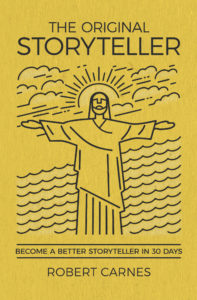
Storytelling is a buzzword tossed around frequently these days, especially in marketing circles. It’s true that telling stories are one of the best ways to stand out among the constant onslaught of content and advertising.
But newsflash: not everything is a story.
So what is a story? It might seem like a silly question. Yet, do we really know what distinguishes a story from everything else? It’s one thing to talk about storytelling and quite another to do it.
Here are four fundamental principles that separate the true stories from the pretenders: character, context, conflict and creation.
Character
Go ahead. Name a story without any characters. Yeah, that’s what I thought.
A character adds a face to the story. They give the events of the story perspective. Characters allow the audience to see themselves in the narrative and empathize.
Without characters, stories would be unrelatable, uninteresting, not to mention, implausible. In other words, not much of a story.
A main character gives the story focus and personality. Character development describes changes that a character undergoes during the course of the narrative. The better the characters, the better the story.
Context
Stories do not exist in a vacuum. They happen in a specific time and place—better known as a setting. The setting gives an audience much-needed context for the story.
When and where a narrative transpires provides the audience with a crucial framework. Afterall, a story taking place in outer space during the year 2052 might look slightly different from a story happening in Renaissance-era Italy.
Setting provides the internal context for every story. Stories also have two important external contexts—audience and medium.
Who are you telling the story to? And how are they receiving the story? Audiences matter because who you’re talking to can change what you say. The same is true for the storytelling format. Stories in printed books are experienced differently from those shown in online videos.
Always consider your setting, audience and medium when storytelling. Because context matters.
Conflict
The not-so-secret ingredient to a good story is conflict. What’s the point of a story without conflict? A story without conflict is like a sporting event without an opponent.
Conflict drives the action of the story. It supplies the tension that motivates the characters. Conflict also gives a framework to the narrative. Stories typically begin with the introduction of a conflict. They end once the conflict is resolved.
Without conflict, there’s nothing to move the characters or frame the narrative. Without conflict, there’s nothing to resolve at the end. Without conflict, there’s no reason to tell the story.
More than any other principle, conflict is the most indicative of true storytelling. Any anecdote or rant can have characters and setting. But conflict sets real stories apart from the rest.
When you’re telling a story, be sure to find the tension and bring it to the forefront.
Creation
If the first three principles define the story, this one defines the telling. Creation pulls together characters, context and conflict into one comprehensive narrative.
The greatest characters and most interesting conflict in the world are no good if they aren’t shared in a compelling way.
Every storyteller has their own unique voice and style. These both come into play as you craft the story in your own way. From the words used, to how the narrative is structured, creativity plays an important role in the storytelling process.
Two virtues really matter when creating a good story—clarity and consistency. A story is no good if it’s too confusing or can’t agree with itself. As long as you remain clear and consistent, you can’t go wrong.
The Original Storyteller
Now you know how to identify a story from the other nonsense floating about. But how do you put these principles into practice and start telling better stories? I’m glad you asked.
These were the questions that inspired me to write my new book, The Original Storyteller.
It’s a daily devotional dedicated to helping you become a better storytelling in 30 days. Best of all, it draws on the example of other great stories to show you how it’s done.
The Original Storyteller now available on Amazon in both print and digital formats. Be sure to also check out www.OriginalStoryteller.com for more information and a free preview of the book.


